Effect of Parameters of Ditch Geometry on the Uniformity of Water Filling in Ship Lock Chambers
Abstract
:1. Introduction
2. Materials and Methods
2.1. Geometry and Simulated Cases
2.2. Numerical Model
2.3. Index
2.4. Mesh Sensitivity
2.5. Model Validation
3. Results and Discussion
3.1. Effect of Sill Height
3.1.1. Cross-Sectional Velocity Distribution
3.1.2. Filling Uniformity of the Lock Chamber
3.2. Effect of Ditch Width
3.2.1. Cross-Sectional Velocity Distribution
3.2.2. Filling Uniformity of a Lock Chamber
3.3. Effect of Ditch Depth
3.3.1. Cross-Sectional Velocity Distribution
3.3.2. Filling Uniformity of the Lock Chamber
3.4. Comprehensive Analysis of Multiple Factors
3.4.1. Relationship between (mBL)/(Ka) and VZA
3.4.2. Relationship between (D − d)/B and VZA
3.4.3. Relationship between (D − d)/(BL) and VZA
4. Conclusions
- (1)
- In the process of water filling in the lock chamber, under the constraint of limited space, the flow direction of the high-velocity port jet is adjusted from the horizontal direction to the oblique direction. Some of the water flows directly into the lock chamber from the port jet. Another proportion of the water flow comes from diversion and diffusion after the collision between the jet and the side wall of the ditch. The velocity decreases due to diffusion and mixing, and the flow pattern is complex. The uniformity of water filling is closely related to the arrangement of the ditch geometry.
- (2)
- The larger the ditch width and depth, the larger the energy dissipation and diffusion space of the flow, and the higher the uniformity of water filling in the lock chamber. Within the scope of the calculation, the VZA basically decreases with the increase in the (mBL)/(Ka). When the (mBL)/(Ka) is approximately 2.2, the VZA remains basically unchanged with the increase in the (mBL)/(Ka). The design should restrict the (mBL)/(Ka) to approximately 2.2 or above.
- (3)
- The retaining sill on the side wall of the ditch can block the climbing flow state on the side wall. This has a guiding effect on the flow and is conducive to adjusting its transverse distribution. Within the scope of the calculation, the VZA basically first decreases and then increases with the increase in the (D − d)/B and (D − d)/(BL). When the (D − d)/B is approximately 0.24~0.5 or the (D − d)/(BL) is approximately 0.04~0.11, the uniformity of water filling in the lock chamber is improved.
Author Contributions
Funding
Institutional Review Board Statement
Informed Consent Statement
Data Availability Statement
Conflicts of Interest
References
- Barbosa, F.G.P.; de Figueiredo, N.M.; Filho, L.C.P.C.; Borges, H.M. Computational Tool for Sizing and Optimization of Planimetric Geometric Parameters of Inland Navigation Channels and of Port Access in Brazil. J. Waterw. Port Coast. Ocean Eng. 2021, 147, 04020044. [Google Scholar] [CrossRef]
- Jiang, P.; Tong, S.; Xu, G.; Huang, G. Review and application of determination methods on navigable hydraulic index of rapids in mountainous river. Ocean Eng. 2022, 248, 110830. [Google Scholar] [CrossRef]
- Helal, E.; Elsersawy, H.; Hamed, E.; Abdelhaleem, F.S. Sustainability of a navigation channel in the Nile River: A case study in Egypt. River Res. Appl. 2020, 36, 1817–1827. [Google Scholar] [CrossRef]
- Liao, P. Improved Analytical Model for Estimating the Capacity of a Waterway Lock. J. Waterw. Port Coast. Ocean Eng. 2018, 144, 04018021. [Google Scholar] [CrossRef]
- Wan, Z.; Li, Y.; Wang, X.; An, J.; Cheng, L.; Liao, Y. Effect of ship-lock-induced surges on navigation safety in a branched lower approach channel system. J. Hydroinform. 2022, 24, 481–496. [Google Scholar] [CrossRef]
- Natale, L.; Savi, F. Minimization of Filling and Emptying Time for Navigation Locks. J. Waterw. Port Coast. Ocean Eng. 2000, 126, 274–280. [Google Scholar] [CrossRef]
- Belzner, F.; Thorenz, C.; Oertel, M. A Modernized Safety Concept for Ship Force Evaluations During Lock Filling Processes. In Proceedings of the PIANC Smart Rivers 2022; Lecture Notes in Civil Engineering; Springer: Singapore, 2023; pp. 271–280. [Google Scholar]
- Yang, Z.; Yang, B.; Chen, M.; Wang, D. Energy dissipation effect and mechanism of open ditch energy dissipater in high-head lock. Port Waterw. Eng. 2009, 12, 168–173. [Google Scholar] [CrossRef]
- Yang, Z.; Chen, M.; Yang, B.; Wang, D. Experimental Study on Energy Dissipation Effect of Chamber Energy Dissipater in Superhigh-Head Lock. J. Chongqing Jiaotong Univ. (Nat. Sci.) 2010, 29, 461–465. [Google Scholar]
- Wang, Z.; Chen, L.; Peng, Y. On form and energy dissipation effect of lock chamber’s open ditch. Port Waterw. Eng. 2015, 7, 129–134. [Google Scholar] [CrossRef]
- Lv, W.; Liu, P.; Chen, L.; Zhang, X. Three-dimensional numerical simulation of energy dissipation effect in energy dissipater of lock chamber open ditch. J. Waterw. Harb. 2013, 34, 508–512. [Google Scholar] [CrossRef]
- Zhu, L. Numerical Simulation Study of Double Ditches detail Optimization for Lock Bottom Long-Culvert Filling and Emptying System. Master’s Thesis, Chongqing Jiaotong University, Chongqing, China, 2016. [Google Scholar]
- Chen, M.; Liu, T.; Li, J.; Huang, H. Energy dissipation characteristics of double-layer side ports in in-chamber culvert designed for large-scale lock chamber with extreme high water head. Chin. J. Hydrodyn. 2022, 37, 301–308. [Google Scholar] [CrossRef]
- Li, J. Research on Energy Dissipation Characteristics of the Open Ditch in Shiplock Chamber with Super Large Water Transmission Power. Master’s Thesis, Chongqing Jiaotong University, Chongqing, China, 2018. [Google Scholar]
- Li, R. Energy Dissipation Characteristics of the Multi-Layer Side Ports in a Long Culvert Designed for a Large-Scale Lock Chamber with 60 m Water Head. Master’s Thesis, Chongqing Jiaotong University, Chongqing, China, 2021. [Google Scholar]
- Zhou, P. Numerical Simulation of Energy Dissipation Characteristics of Cover Plate in Gate Chamber under the Condition of Super Water Transfer Power. Master’s Thesis, Chongqing Jiaotong University, Chongqing, China, 2018. [Google Scholar]
- Ma, X.; Hu, Y.; Li, Z. Impact of an energy dissipator on mooring conditions in ultra-high head locks with a comprehensive uniform-strength evaluation. Ocean Eng. 2022, 266, 112806. [Google Scholar] [CrossRef]
- Wan, Z.; Li, Y.; Cheng, L.; Wang, X.; Wang, B.; An, J. Investigating hydraulic operational schemes of a large-scale multi-lane lock group concerning water-level fluctuations in a branched approach channel system. Ocean Eng. 2022, 260, 111758. [Google Scholar] [CrossRef]
- Wu, Y.; Jiang, Y.; Jiang, B.; Wang, Z. Research and Prospect on Filling and Emptying System of Shiplock with Large-scale and Super-high Head. J. Yangtze River Sci. Res. Inst. 2016, 33, 53–57. [Google Scholar]
- Zhu, L.; Li, J.; Xuan, G.; Yan, X.; Huang, Y. Numerical study of hydraulic characteristics of self-diffluence structure in second diversion port of high-head lock. Hydro-Sci. Eng. 2017, 6, 1–8. [Google Scholar] [CrossRef]
- Li, Z.; Xuan, G. The Approach of Lock Hydraulic System Selection Based on Multiple Factors. In Proceedings of the PIANC Smart Rivers 2022; Lecture Notes in Civil Engineering; Springer: Singapore, 2023; pp. 693–703. [Google Scholar]
- Morgunov, K.P.; Ryabov, G.; Buchnev, I. Determination of the optimal modes of filling and emptying the chamber of the navigational lock of a low-pressure hydroelectric complex. J. Phys. Conf. Ser. 2021, 2061, 012136. [Google Scholar] [CrossRef]
- Nogueira, H.I.S.; Ven, P.v.d.; O’Mahoney, T.; Loor, A.D.; Hout, A.v.d.; Kortlever, W. Effect of Density Differences on the Forces Acting on a Moored Vessel While Operating Navigation Locks. J. Hydraul. Eng. 2018, 144, 04018021. [Google Scholar] [CrossRef]
- Liu, B.; Yang, J.; Huang, Y.; Wang, L. Hydraulic Research on Filling and Emptying System of Water-Saving Ship Lock for Navigation-Power Junction in Mountainous River. In Proceedings of the PIANC Smart Rivers 2022; Lecture Notes in Civil Engineering; Springer: Singapore, 2023; pp. 1492–1501. [Google Scholar]
- Savary, C.; Bertin, B.; Lenaerts, M.; El Ouamari, I.; Bousmar, D. Transverse Mooring Forces Due to Asymmetrical Filling in a Lock with Longitudinal Culverts and Side Ports. In Proceedings of the PIANC Smart Rivers 2022; Lecture Notes in Civil Engineering; Springer: Singapore, 2023; pp. 724–735. [Google Scholar]
- Badano, N.D.; Menéndez, Á.N. Numerical modeling of Reynolds scale effects for filling/emptying system of Panama Canal locks. Water Sci. Eng. 2021, 14, 237–245. [Google Scholar] [CrossRef]
- Calvo Gobbetti, L.E. Design of the filling and emptying system of the new Panama Canal locks. J. Appl. Water Eng. Res. 2013, 1, 28–38. [Google Scholar] [CrossRef]
- Stockstill, R.L.; Berger, R.C. A Three-Dimensional Numerical Model for Flow in a Lock Filling System. In World Environmental and Water Resources Congress 2009; Stockstill, R.L., Berger, R.C., Eds.; ASCE Library: Lawrence, KS, USA, 2009; pp. 1–10. [Google Scholar]
- Kašpar, T. Efficiency of energy dissipation during filling of the navigation lock. In Proceedings of the 15th International Conference on X-ray Microscopy—XRM2022, Hsinchu, Taiwan, 19–24 June 2022. [Google Scholar]
- Thorenz, C.; Schulze, L. Numerical Investigations of Ship Forces During Lockage. J. Coast. Hydraul. Struct. 2021, 1, 27. [Google Scholar] [CrossRef]
- Chen, L.; Liu, P.; Zhang, X.; Peng, Y. Layout of double open trench energy dissipater and energy dissipation characteristics of Guigang second line ship lock chamber. J. Waterw. Harb. 2013, 34, 144–149. [Google Scholar]
- Hite, J.E.; Stockstill, R.L. Hydraulic Design of a Longitudinal Culvert for Lock Filling and Emptying Systems. J. Hydraul. Eng. 2004, 130, 381–388. [Google Scholar] [CrossRef]
- Wang, Y.; Politano, M.; Laughery, R. Towards full predictions of temperature dynamics in McNary Dam forebay using OpenFOAM. Water Sci. Eng. 2013, 6, 317–330. [Google Scholar] [CrossRef]
- Shaheed, R.; Mohammadian, A.; Kheirkhah Gildeh, H. A comparison of standard k–ε and realizable k–ε turbulence models in curved and confluent channels. Environ. Fluid Mech. 2019, 19, 543–568. [Google Scholar] [CrossRef]
- Shayanseresht, S.; Manafpour, M. A Comparative Assessment of Various Turbulence Models Applied for Simulation of Air-Water Flow over Chute Spillway. Period. Polytech. Civ. Eng. 2021, 65, 1200–1212. [Google Scholar] [CrossRef]
- Santos, H.A.; Pinheiro, A.P.; Mendes, L.M.M.; Junho, R.A.C. Turbulent Flow in a Central Vertical Slot Fishway: Numerical Assessment with RANS and LES Schemes. J. Irrig. Drain. Eng. 2022, 148, 04022025. [Google Scholar] [CrossRef]
- Zhang, X.; Chen, M.; Xu, G.; Huang, H. An experimental study on the flow characteristics of a three-dimensional turbulent wall jet in a limited space. Adv. Water Sci. 2019, 30, 93–101. [Google Scholar] [CrossRef]
- Chen, M.; Chen, Y.; Miao, J.; Huang, H. Energy dissipation characteristics of the open ditch located in a large-scale ship lock chamber with an extreme high water head. Hydro-Sci. Eng. 2022, 5, 69–77. [Google Scholar] [CrossRef]
- JTJ 306-2001; Design Code for Filling and Emptying System of Shiplocks. Ministry of Transport of the People’s Republic of China: Beijing, China, 2001.
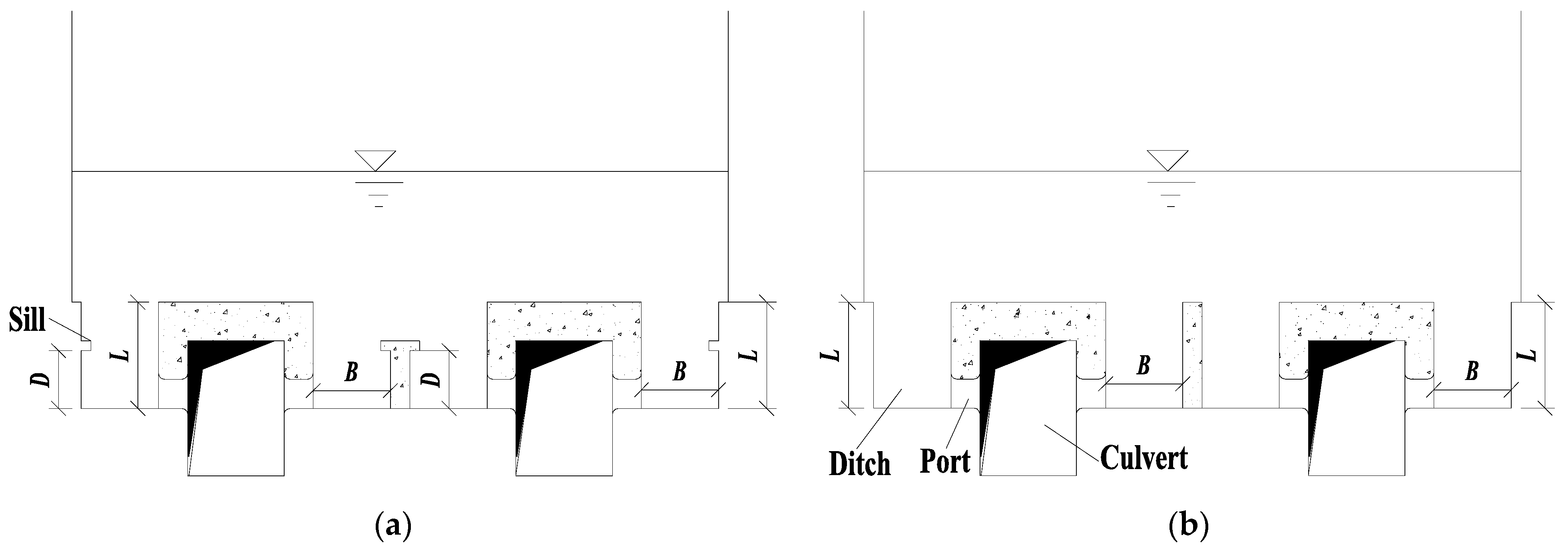
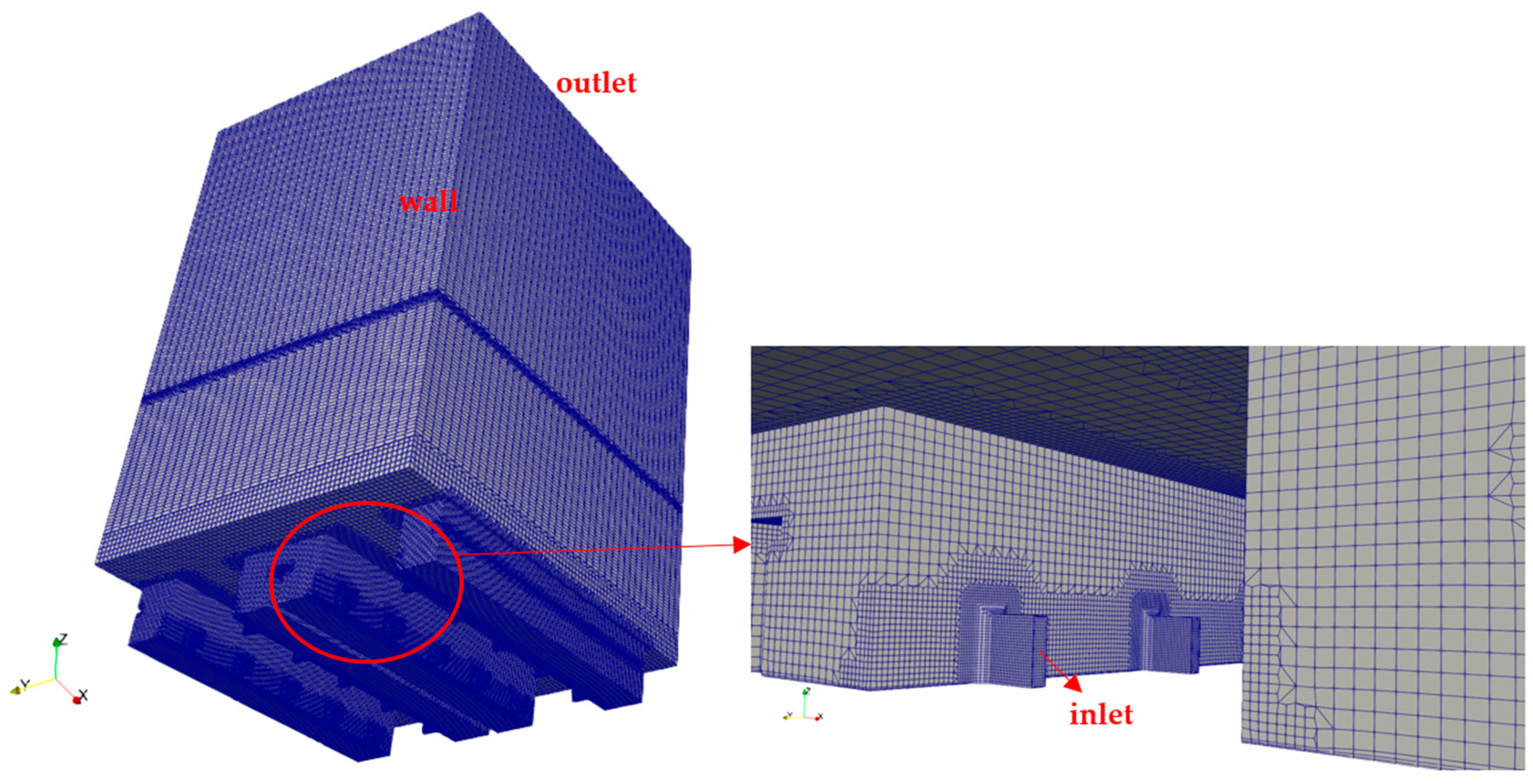




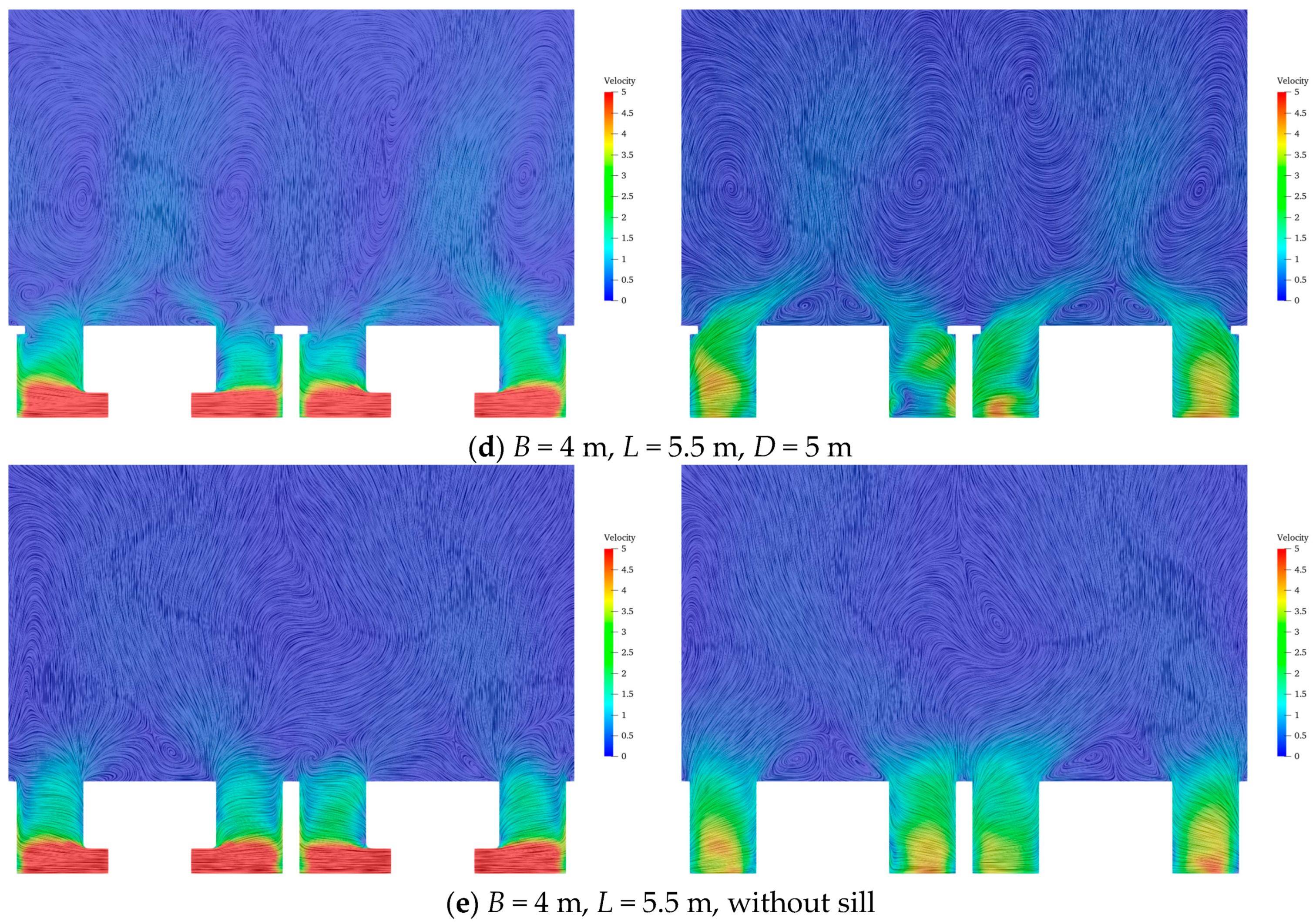



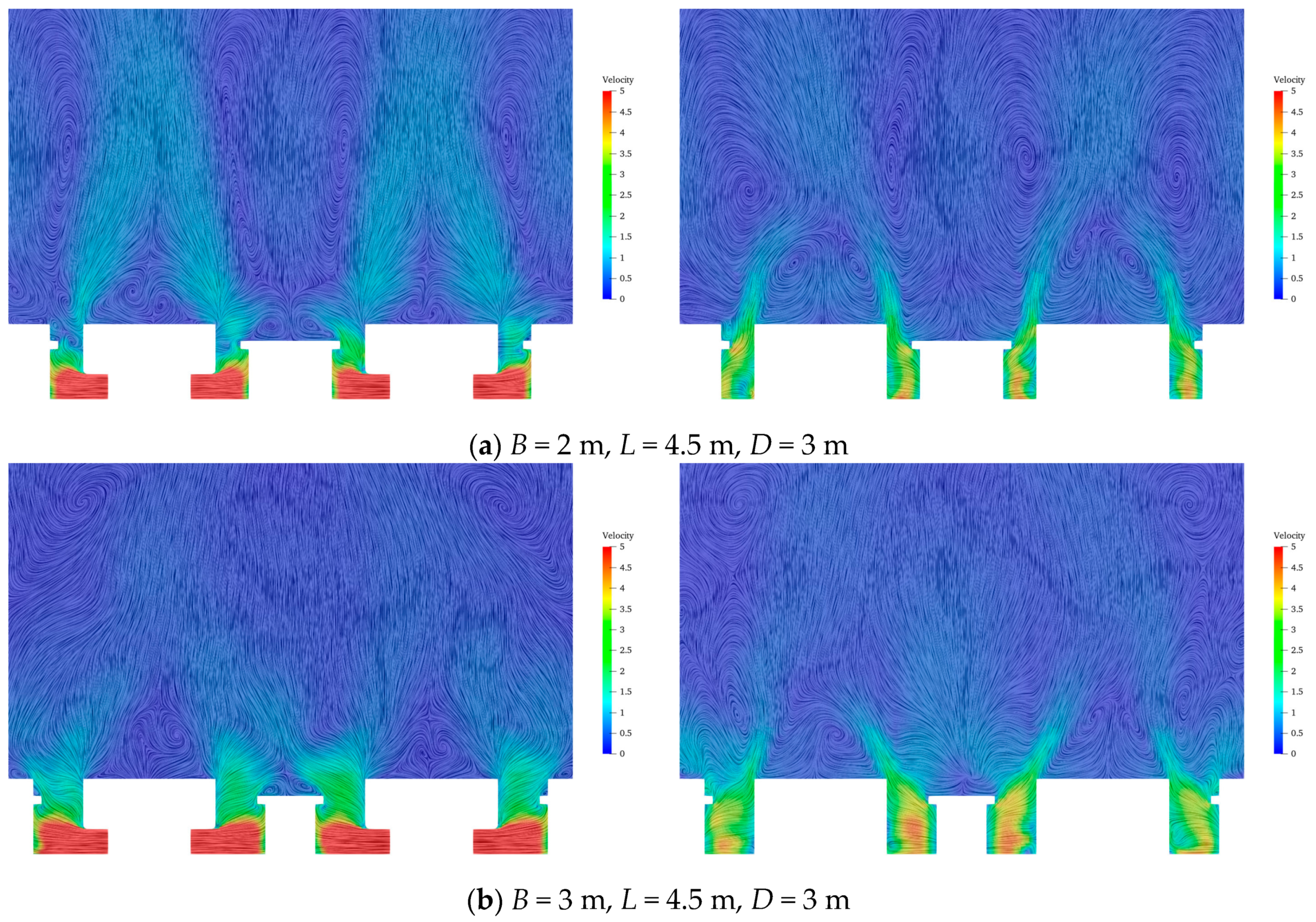
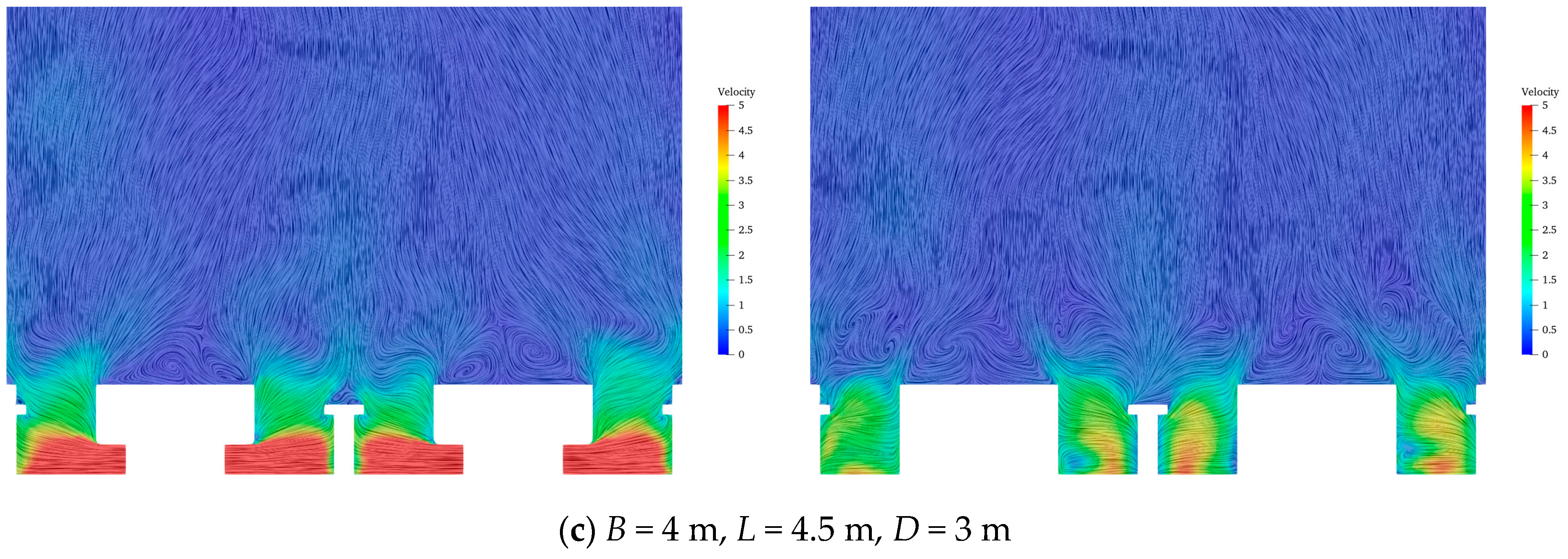
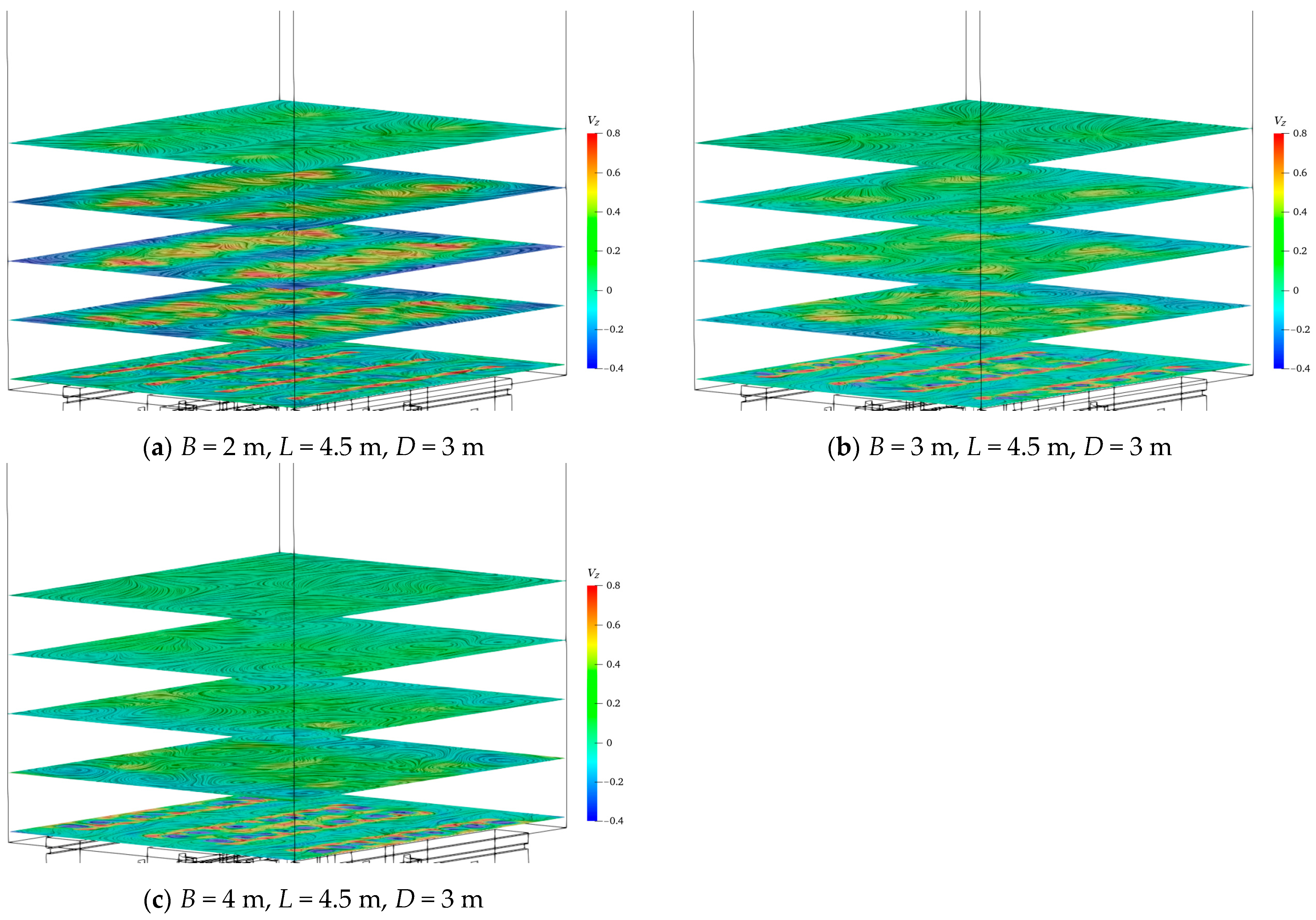
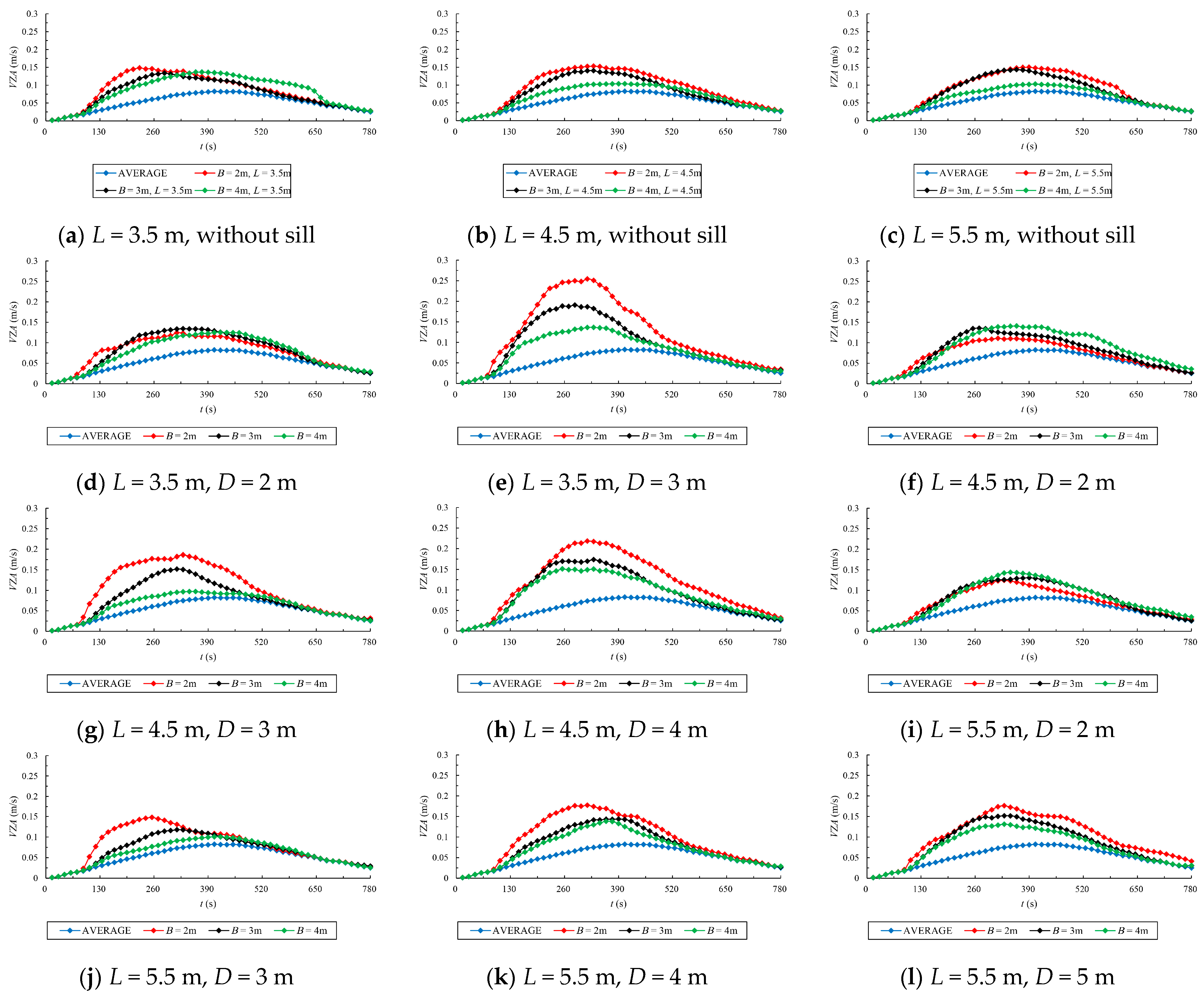

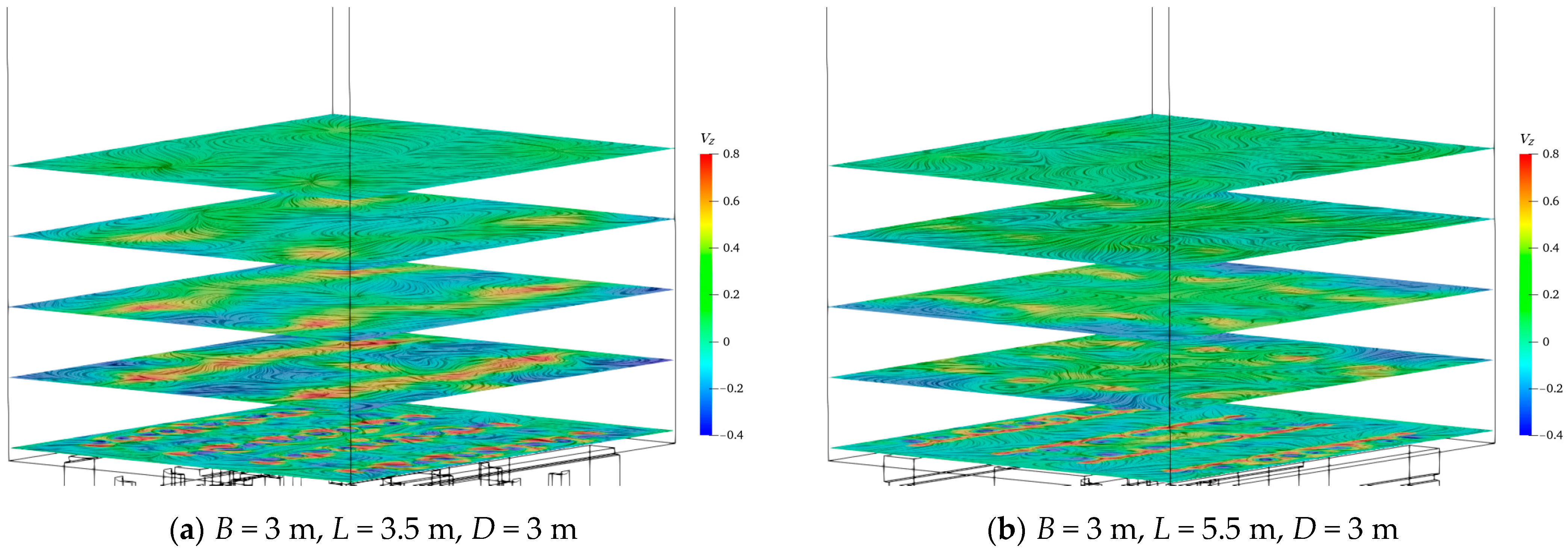
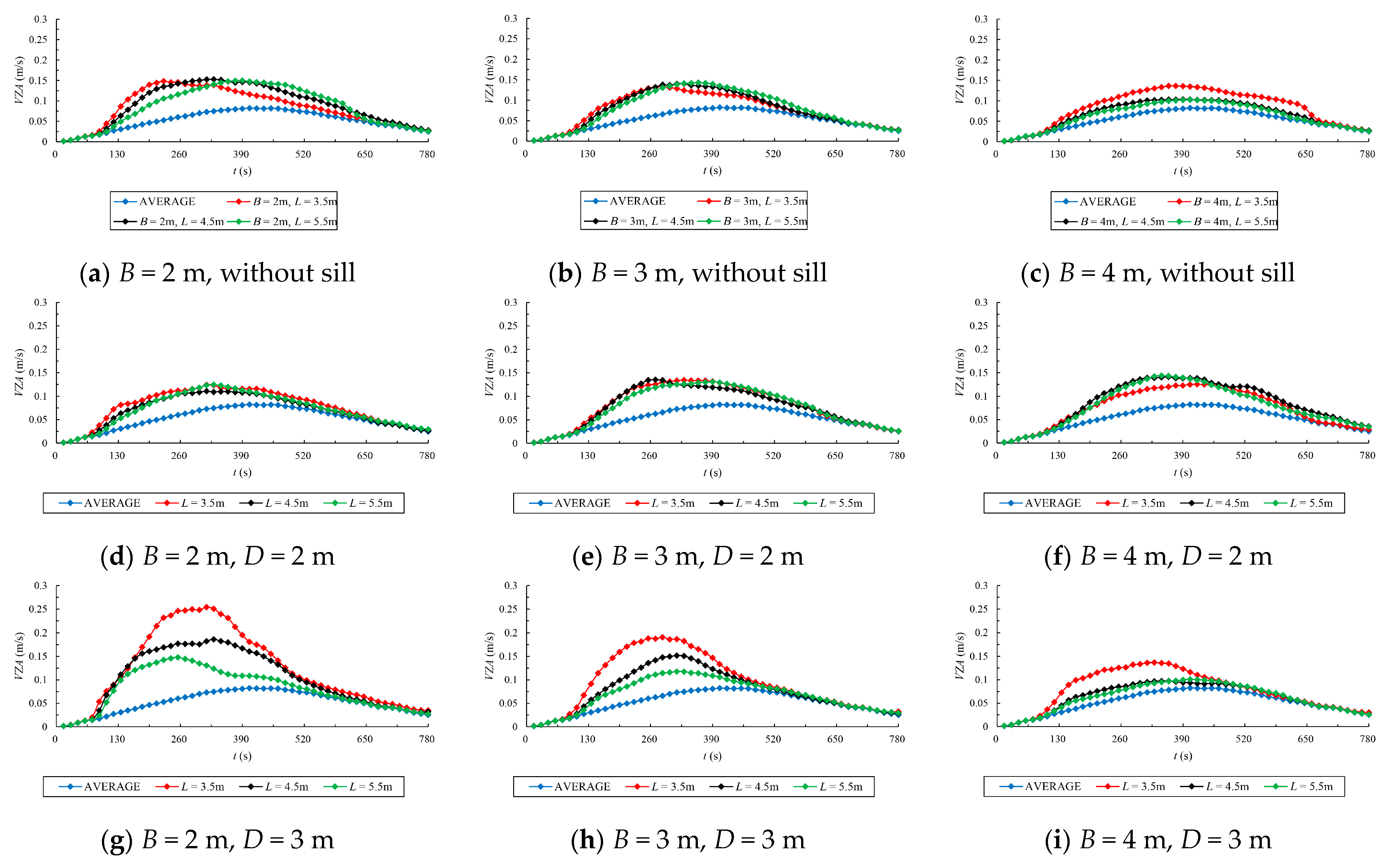


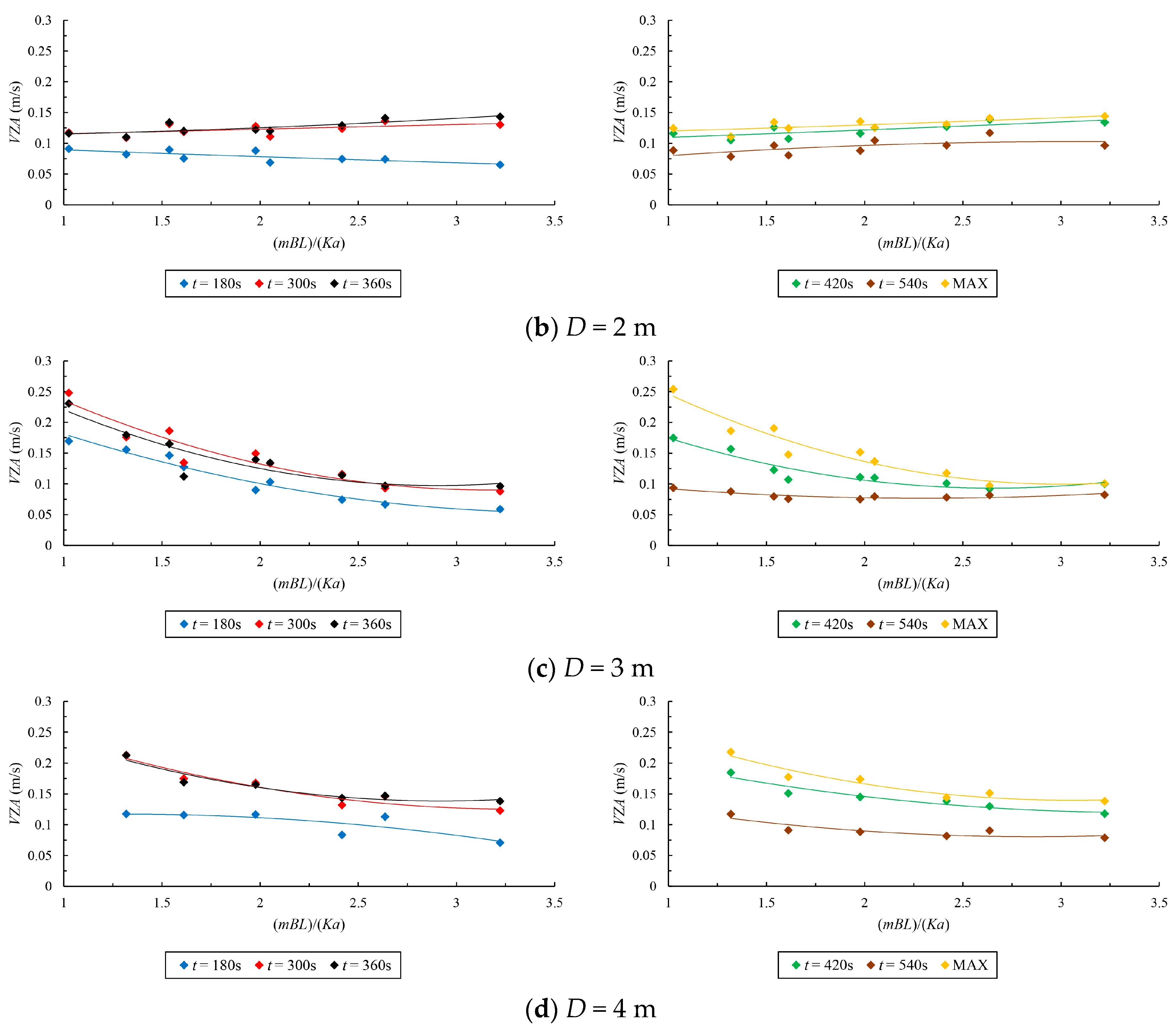


| Cases | B (m) | L (m) | D (m) | Cases | B (m) | L (m) | D (m) |
|---|---|---|---|---|---|---|---|
| A1 | 2 | 3.5 | 2 | A19 | 3 | 4.5 | Without sill |
| A2 | 2 | 3.5 | 3 | A20 | 3 | 5.5 | 2 |
| A3 | 2 | 3.5 | Without sill | A21 | 3 | 5.5 | 3 |
| A4 | 2 | 4.5 | 2 | A22 | 3 | 5.5 | 4 |
| A5 | 2 | 4.5 | 3 | A23 | 3 | 5.5 | 5 |
| A6 | 2 | 4.5 | 4 | A24 | 3 | 5.5 | Without sill |
| A7 | 2 | 4.5 | Without sill | A25 | 4 | 3.5 | 2 |
| A8 | 2 | 5.5 | 2 | A26 | 4 | 3.5 | 3 |
| A9 | 2 | 5.5 | 3 | A27 | 4 | 3.5 | Without sill |
| A10 | 2 | 5.5 | 4 | A28 | 4 | 4.5 | 2 |
| A11 | 2 | 5.5 | 5 | A29 | 4 | 4.5 | 3 |
| A12 | 2 | 5.5 | Without sill | A30 | 4 | 4.5 | 4 |
| A13 | 3 | 3.5 | 2 | A31 | 4 | 4.5 | Without sill |
| A14 | 3 | 3.5 | 3 | A32 | 4 | 5.5 | 2 |
| A15 | 3 | 3.5 | Without sill | A33 | 4 | 5.5 | 3 |
| A16 | 3 | 4.5 | 2 | A34 | 4 | 5.5 | 4 |
| A17 | 3 | 4.5 | 3 | A35 | 4 | 5.5 | 5 |
| A18 | 3 | 4.5 | 4 | A36 | 4 | 5.5 | Without sill |
| Boundary | Alpha.Water | U | p_rgh | k | Epsilon | Nut |
|---|---|---|---|---|---|---|
| inlet | fixedValue | uniformFixedValue | fixedFluxPressure | fixedValue | fixedValue | calculated |
| outlet | fixedValue | zeroGradient | fixedValue | zeroGradient | zeroGradient | calculated |
| wall | zeroGradient | noSlip | fixedFluxPressure | kqRWallFunction | epsilonWallFunction | nutkWallFunction |
| ddtSchemes | Euler |
| gradSchemes | Gauss linear |
| div(rhoPhi,U) | Gauss linearUpwind grad(U) |
| div(phi,alpha) | Gauss interfaceCompression vanLeer 1 |
| div(phi,k) | Gauss upwind |
| div(phi,epsilon) | Gauss upwind |
| div(((rho*nuEff)*dev2(T(grad(U))))) | Gauss linear |
| laplacianSchemes | Gauss linear corrected |
| interpolationSchemes | linear |
| snGradSchemes | corrected |
| Mesh Size | Port (m) | Local Area (m) | Ditch (m) | Bottom of Lock Chamber (m) | Lock Chamber (Horizontal/Vertical) (m) | Mesh Number (Initial/after Adaptation) |
|---|---|---|---|---|---|---|
| Coarse | 0.075 | 0.15 | 0.3 | 0.6 | 1.2/0.4 | 460,000/530,000 |
| Medium | 0.0625 | 0.125 | 0.25 | 0.5 | 1/0.333 | 800,000/940,000 |
| Fine | 0.05 | 0.1 | 0.2 | 0.4 | 0.8/0.267 | 1,520,000/1,750,000 |
Disclaimer/Publisher’s Note: The statements, opinions and data contained in all publications are solely those of the individual author(s) and contributor(s) and not of MDPI and/or the editor(s). MDPI and/or the editor(s) disclaim responsibility for any injury to people or property resulting from any ideas, methods, instructions or products referred to in the content. |
© 2024 by the authors. Licensee MDPI, Basel, Switzerland. This article is an open access article distributed under the terms and conditions of the Creative Commons Attribution (CC BY) license (https://creativecommons.org/licenses/by/4.0/).
Share and Cite
Hu, Q.; Li, Y.; Zhu, L. Effect of Parameters of Ditch Geometry on the Uniformity of Water Filling in Ship Lock Chambers. J. Mar. Sci. Eng. 2024, 12, 86. https://doi.org/10.3390/jmse12010086
Hu Q, Li Y, Zhu L. Effect of Parameters of Ditch Geometry on the Uniformity of Water Filling in Ship Lock Chambers. Journal of Marine Science and Engineering. 2024; 12(1):86. https://doi.org/10.3390/jmse12010086
Chicago/Turabian StyleHu, Qiaoyi, Yun Li, and Long Zhu. 2024. "Effect of Parameters of Ditch Geometry on the Uniformity of Water Filling in Ship Lock Chambers" Journal of Marine Science and Engineering 12, no. 1: 86. https://doi.org/10.3390/jmse12010086




